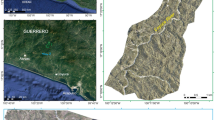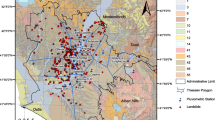Abstract
Landslide susceptibility maps can be a useful tool to support holistic urban planning in mountainous environments. Data-driven methods for landslide susceptibility modeling work well even in data scarce areas, and there is an increasing relevance of machine learning methods that help analyze efficiently large and complex datasets. In this contribution we present some of our study examples to show how data quality, quantity, complexity, and preparation can have major effects on the outcomes of landslide susceptibility modeling. The aforementioned aspects are too often neglected in spite of their relevance, both in data scarce, but also data rich areas. We also use these examples to discuss the way we evaluate landslide susceptibility models, as the spatial performance of landslide susceptibility maps often differs from the mathematical performance. We finally discuss the necessity of standards for input data, modeling results and result communication to improve the usability of landslide susceptibility models in urban planning.
Access this chapter
Tax calculation will be finalised at checkout
Purchases are for personal use only
Similar content being viewed by others
References
Alvioli M, Marchesini I, Reichenbach P, Rossi M, Ardizzone F, Fiorucci F, Guzzetti F (2016) Automatic delineation of geomorphological slope units with r.slopeunits v1.0 and their optimization for landslide susceptibility modeling. Geoscientific Model Dev 9(11):3975–3991
Behling R, Roessner S, Kaufmann H, Kleinschmit B (2014) Automated spatiotemporal landslide mapping over large areas using rapideye time series data. Remote Sens 6(9):8026–8055
Braun A, Garcia Urquia EL, Lopez RM, Yamagishi H (2019) Landslide susceptibility mapping in Tegucigalpa, Honduras, using data mining methods. In IAEG/AEG Annual Meeting Proceedings, San Francisco, California, vol 1, pp 207–215 (2018)
Carrara A, Cardinali M, Detti R, Guzzetti F, Pasqui V, Reichenbach P (1991) GIS techniques and statistical models in evaluating landslide hazard. Earth Surf Proc Land 16(5):427–445
Dohmen K (2019) Landslide factors and susceptibility analysis using data mining methods for large study areas: a case study from the Tien Shan Mountains, Central Asia. Master thesis, Technische Universität Berlin, Berlin, Germany
Fell R, Corominas J, Bonnard C, Cascini L, Leroi E, Savage W (2008) Guidelines for landslide susceptibility, hazard and risk zoning for land-use planning. Eng Geol 102(3–4):99–111
Havenith HB, Torgoev A, Schlögel R, Braun A, Torgoev I, Ischuk A (2015) Tien Shan geohazards database: landslide susceptibility analysis. Geomorphology 249:32–43
Hearn GJ, Hart AB (2019) Landslide susceptibility mapping: a practitioner’s view. Bull Eng Geol Env 78(8):5811–5826
JAXA (Japan Aerospace Exploration Agency) ALOS Global Digital Surface Model ‘ALOS World 3D—30 m’ (AW3D30 DSM Ver.1.0, 2.0 and 2.1), data available from the JAXA web interface (2016). http://www.eorc.jaxa.jp/ALOS/en/aw3d30/data/index.htm
Pyle D (1999) Data Preparation for Data Mining. Morgan Kaufmann, San Francisco. https://books.google.de/books?hl=de&lr=&id=hhdVr9F-JfAC&oi=fnd&pg=PA6&dq=Data+Preparation+for+Data+Mining&ots=6h9RbOGw5w&sig=elC6MNiVplWM14O5nx1ajw6drj0#v=onepage&q&f=false
Reichenbach P, Rossi M, Malamud B, Mihir M, Guzzetti F (2018) A review of statistically-based landslide susceptibility models. Earth Sci Rev 180:60–91
Schlögel R, Marchesini I, Alvioli M, Reichenbach P, Rossi M, Malet J (2018) Optimizing landslide susceptibility zonation: effects of DEM spatial resolution and slope unit delineation on logistic regression models. Geomorphology 301:10–20
Schlögel R, Doubre C, Malet J, Masson F (2015) Landslide deformation monitoring with ALOS/PALSAR imagery: a D-InSAR geomorphological interpretation method. Geomorphology 231:314–330
Teimouri M, Kornejady A (2019) The dilemma of determining the superiority of data mining models: optimal sampling balance and end users’ perspectives matter. Bull Eng Geol Environ
UNISDR (United Nations International Strategy for Disaster Reduction) (2015) Sendai framework for disaster risk reduction 2015–2030. http://www.wcdrr.org/uploads/Sendai_Framework_for_Disaster_Risk_Reduction_2015-2030.pdf. Accessed 28 Jan 2020
Van Westen CJ, Van Asch TW, Soeters R (2006) Landslide hazard and risk zonation—why is it still so difficult? Bull Eng Geol Env 65(2):167–184
Acknowledgements
Many people contributed to the presented case studies, namely Luqing Zhang, Xueliang Wang, Zhenhua Han, and Jian Zhou, Elias Leonardo Garcia Urquia, Rigoberto Moncada Lopez, and Hiromitsu Yamagishi. Part of this work was funded by the Natural Science Foundation of China (Grant No. 41402285) and the Chinese Academy of Sciences President’s International Fellowship Initiative (Grant No. 2016PZ032).
Author information
Authors and Affiliations
Corresponding author
Editor information
Editors and Affiliations
Rights and permissions
Copyright information
© 2021 Springer Nature Switzerland AG
About this chapter
Cite this chapter
Braun, A., Dohmen, K., Havenith, HB., Fernandez-Steeger, T. (2021). Overcoming Data Scarcity Related Issues for Landslide Susceptibility Modeling with Machine Learning. In: Guzzetti, F., Mihalić Arbanas, S., Reichenbach, P., Sassa, K., Bobrowsky, P.T., Takara, K. (eds) Understanding and Reducing Landslide Disaster Risk. WLF 2020. ICL Contribution to Landslide Disaster Risk Reduction. Springer, Cham. https://doi.org/10.1007/978-3-030-60227-7_26
Download citation
DOI: https://doi.org/10.1007/978-3-030-60227-7_26
Published:
Publisher Name: Springer, Cham
Print ISBN: 978-3-030-60226-0
Online ISBN: 978-3-030-60227-7
eBook Packages: Earth and Environmental ScienceEarth and Environmental Science (R0)




